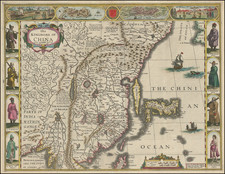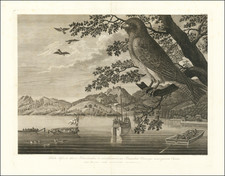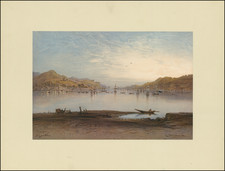Stunning Wall Map of Central Honshu Showing Tokyo and Mount Fuji
Elegant Edo-period woodcut showing in staggering detail the southern coast of Honshu. The map spans from the city of Hamamatsu to the northern parts of Ibaraki, and as far inland as the central portions of the Nagano and Gunma prefectures. The map is centered around Mount Fuji, showing the thirteen provinces, or han as they were known during the Edo Period, from which the famous volcano can be seen.
The map is stunningly designed, showing numerous cities and towns. Central Tokyo is shown in red, near the center of the map, but suburbs of the city can already be seen to radiate up the Tone River Valley. Numerous annotations adorn Mt. Fuji. Relief is shown pictorially.
Three additional blocks of text adorn the map, including a legend in the lower right of the map that shows symbols for cities, roads, province boundaries, scenic spots, and more. The thirteen Edo Provinces shown are the Kant, Sagami, Musashi, Kazusa, Shimofusa, Awa, Kozuke, Shimotsuke, Hitachi, Izu, Suruga, Totomi, Kai, and Shinano provinces.
In Romaji script, the title for this map is Fujimi jūsanshū yochi no zenzu. Akiyama Einen, the cartographer, was originally from the city of Edo. The editor, Funakoshi Shugu, originated from Nagato Province (the modern-day Yamaguchi Prefecture) and was a Confucian scholar. The work is dedicated to Funahashi Akira.
This map is dated to Tenpō 14, which corresponds to 1843. Dating for the Tenpō era starting during the great fire of Edo and the Kyoto earthquake in 1830.
Edo Period Cartography
Pre-Meiji Restoration cartography contained a remarkable diversity of styles of and uses for maps. Maps during this period were produced for several different purposes, including wayfinding, administration, propaganda, and also decoration. The lack of preferred directionality to this map (north is to the upper left of the map) and the size speak towards original method of consulting this map, when users would have lain the map of the floor and viewed the map from the edges.
The woodblock printing used for Japanese maps had a distinct advantage over European copperplate maps, in that color prints could be developed. This produced impressive results, as seen in the present map.
Despite the advantages of European survey equipment, the maps of Japan were extremely accurate for the more limited techniques which were used. As such, at the end of the Edo Period, maps such as this one would be reinterpreted by western cartographers in their maps of the Japanese Islands.














![Il Disegno Della Terza Parte Dell' Asia [Gastaldi's Wall Map of SE Asia with extra panels!]](https://storage.googleapis.com/raremaps/img/small/30554hbp.jpg)

![[ Tokyo ] Map of the Suburbs of the Eastern Capital. Or Edo.](https://storage.googleapis.com/raremaps/img/small/102002.jpg)